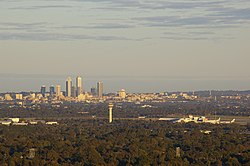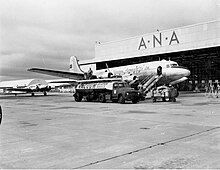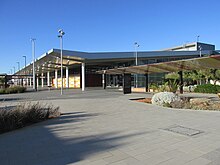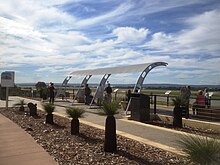Perth Airport
It is the fourth busiest airport in Australia measured by passenger movements and falls within the boundaries of the cities of Belmont, Kalamunda and Swan.
The other is 42 km (26 mi) south-west of Perth Airport, and is a part of the military base of HMAS Stirling on Garden Island.
The airport saw strong passenger growth from 2000 to 2012, primarily due to the state's prolonged mining boom and an increase in traffic from international low-cost carrier airlines.
[7][8] The City of Canning, one area that is affected, accepts that "aircraft noise is an important issue" and that "[it] does impact heavily on those suburbs under the flightpaths".
[12] By the end of the 1930s, it became clear that the Maylands Aerodrome was limited in the size and speed of aircraft it was able to handle thus causing them to seek an alternative site for a future airport.
The site selected in what was at the time Guildford, was an area of land granted by Governor James Stirling to local man John Scott, which later became the long disused Dunreath Golf Course.
A yeoman farmer from Lanarkshire, Scotland who arrived in Western Australia in March 1831, after a voyage of about 90 days in the schooner Eliza of 343 tons.
[13]Even before civil aviation operations could commence at the new site, the onset of World War II saw the facility being redesigned for military purposes as a temporary base for the Royal Australian Air Force and United States Navy, known as "RAAF Station Guildford", primarily to supplement RAAF Base Pearce.
[12] The move was agreed to by the government, as the larger types of aircraft of the day being operated by the two airlines could simply not be handled at Maylands, notwithstanding the small grass airfield, lack of passenger facilities, and approaches being difficult due to surrounding industrial infrastructure.
[12] On a large open airfield with plenty of space, an unobtrusive control tower was hidden away amongst a collection of buildings inherited from the wartime operations at the site.
[12] The Department of Civil Aviation inherited a large number of operating vehicles from the former military occupants, including an assortment of vehicles including (Ford or Chevrolet) Blitz wagons, Dodge command cars and weapon carriers, large trucks and various makes of fire tenders, jeeps and ambulances.
[12] This new terminal was being constructed using steel and cladding recycled from American-built military quonset buildings being dismantled and shipped over from Manus Island.
[12] It was also on this day that Qantas commenced its Wallaby service using Lockheed Constellations from Sydney to South Africa via Perth, the Cocos Islands and Mauritius.
[12] As the aircraft of the day grew faster more demanding due to their sophistication, facilities at the airport continued to improve to accommodate them.
[12] By the mid-1960s the airport was serving its first domestic pure jet engine aircraft, commencing with a Boeing 727 in 1964, and the Douglas DC-9 in 1967, both types operated by TAA and Ansett ANA.
[17] When it opened, the terminal's facilities included an observation deck, a pond with black swans, and a cocktail lounge named the Orbit Inne, which became popular with locals as it was the only place in Perth that served drinks on Sunday nights.
[12][17] In November 1980, the Federal Transport Minister, Ralph Hunt, announced that a new international terminal would be built in Perth at a cost of $26 million (1980).
The second A380 to visit the airport was an Emirates aircraft which made an emergency landing on 15 August 2009, after a passenger on a Dubai to Sydney flight suffered a stroke.
[24] In 2012, the Australian Competition & Consumer Commission (ACCC) released a report rating the Perth Airport as the worst in Australia, as judged by airlines.
[34] Virgin Australia's partner, Etihad Airways began daily direct services from its hub in Abu Dhabi on 16 July 2014;[35] the pier ensures quick and seamless transfers between the two airlines.
[42] On 28 June 2024, Rex Airlines commenced operations to Adelaide using Embraer E190s from National Jet Express, and to Melbourne using their own Boeing 737 aircraft.
[50] The upgrades involved significant strengthening works and enlargement of turning nodes to accommodate regular operations by wide bodied aircraft, including the Airbus A380.
[51] In March 1988, surface observations were moved to the recently vacated old airport tower on the northern side of the airfield (near what is now Terminal 3).
The Royal Automobile Club of Western Australia had a purpose-built driver training facility at Perth Airport, the only one of its kind in the state.
These flights, using a Boeing 787 Dreamliner, depart Perth from Terminals 3 and 4, and provide a guided aerial tour of Antarctica before returning to Australia.
A number of car rental companies have set up operations at the airport, and all terminals feature pick-up and drop-off areas dedicated to taxis and rideshare services.
The other main rotor blade severed the tail boom which fell free of the helicopter striking the side of the tower on its way to the ground.
[104] However, the consolidation process faced protracted delays due to Qantas initially preferring to continue operating out of Terminals 3 and 4, a stance that drew criticism from both Perth Airport and the Western Australian state government.
[105][106] Qantas' transfer to Terminal 1 had been initially set to be completed by late 2025, but was pushed back due to the COVID-19 pandemic affecting air travel.
[105] Qantas had also cited a desire to upgrade and build out their current Perth hub in order to launch new international services before committing to a move to new facilities “over the long term”.












